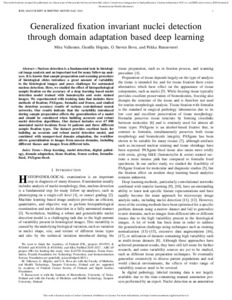Generalized fixation invariant nuclei detection through domain adaptation based deep learning
Ruusuvuori Pekka; Valkonen Mira; Högnäs Gunilla; Bova G Steven
Generalized fixation invariant nuclei detection through domain adaptation based deep learning
Ruusuvuori Pekka
Valkonen Mira
Högnäs Gunilla
Bova G Steven
Julkaisun pysyvä osoite on:
https://urn.fi/URN:NBN:fi-fe2021042822014
https://urn.fi/URN:NBN:fi-fe2021042822014
Tiivistelmä
Nucleus detection is a fundamental task in histological image analysis and an important tool for many follow up analyses. It is known that sample preparation and scanning procedure of histological slides introduce a great amount of variability to the histological images and poses challenges for automated nucleus detection. Here, we studied the effect of histopathological sample fixation on the accuracy of a deep learning based nuclei detection model trained with hematoxylin and eosin stained images. We experimented with training data that includes three methods of fixation; PAXgene, formalin and frozen, and studied the detection accuracy results of various convolutional neural networks. Our results indicate that the variability introduced during sample preparation affects the generalization of a model and should be considered when building accurate and robust nuclei detection algorithms. Our dataset includes over 67 000 annotated nuclei locations from 16 patients and three different sample fixation types. The dataset provides excellent basis for building an accurate and robust nuclei detection model, and combined with unsupervised domain adaptation, the workflow allows generalization to images from unseen domains, including different tissues and images from different labs.
Kokoelmat
- Rinnakkaistallenteet [19218]
